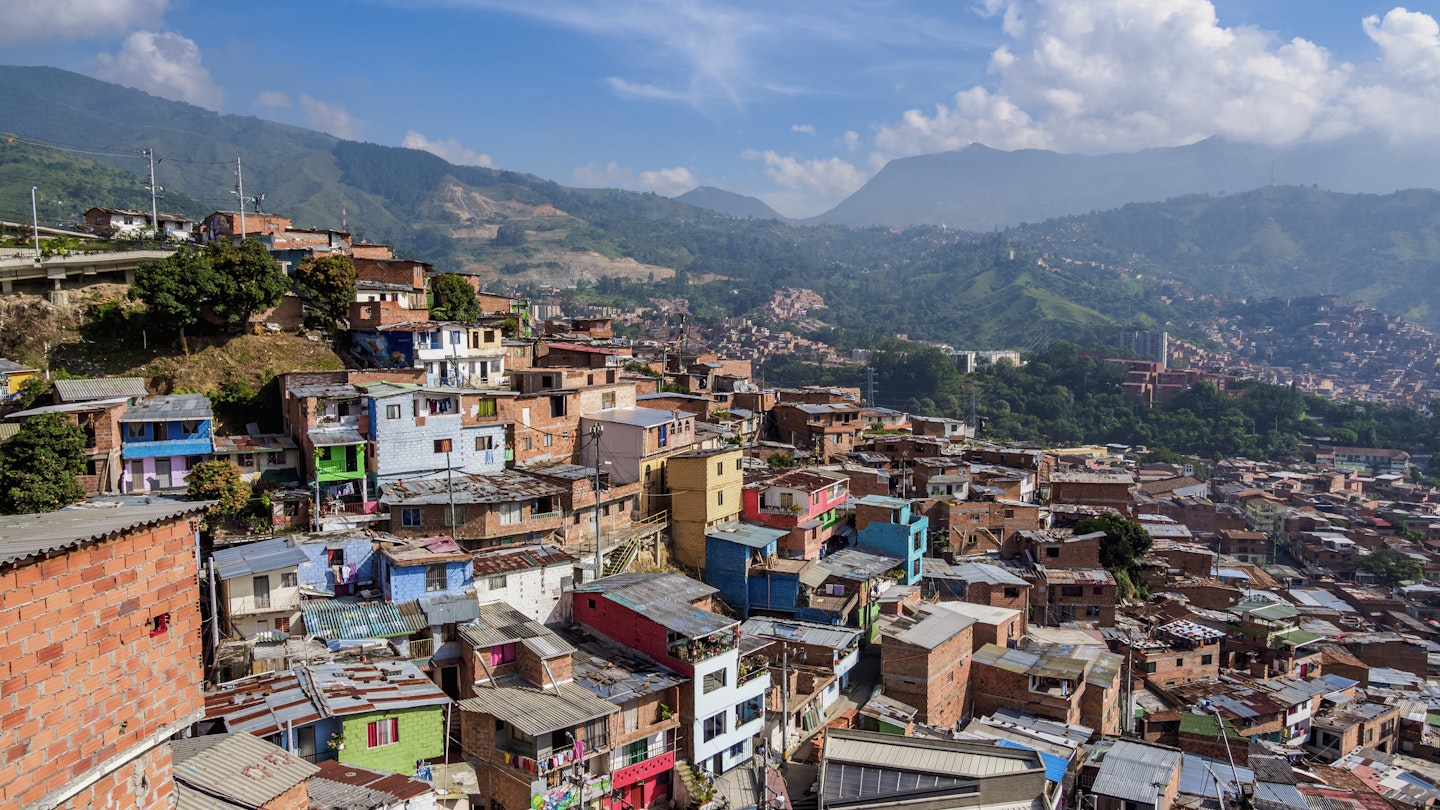Your Guide to Getting Around Medellín
As the Ralph Waldo Emerson adage goes, “It’s not about the destination, it’s about the journey.” In the case of vibrant Medellín, getting to wherever you need to go is half – if not more – of the fun.
Medellín has spent years developing an integrated public-transit plan known as Movilidad Inteligente, whose many components have garnered worldwide acclaim. With a sparkling metro set-up, a gondola system rising into the Andes Mountains, modern trams, and (of course) swarms of old-school buses and cars crawling through traffic, you’ll have no shortage of transportation options in the City of Eternal Spring. Here’s our guide to getting around Medellín.
Medellín by Rail
Medellín is home to Colombia’s only metro system – and it’s a major point of pride for the city. Multimodal and seamless to use, the network often provides a memorable and picturesque experience. The Medellín metro setup encompasses above-ground rail lines, a gondola/cable car system (Metrocable), and a tram. In many instances, a trip may involve two or more of these modes of transport.
The rail system comprises two lines. Line A runs north to south along the spine of Aburrá Valley and the core of the city, with 21 total stations between Niquía and La Estrella. Line B runs east to west and has seven total stations between San Antonio and San Javier. The San Antonio station is where the lines meet. Regardless of where your journey starts and ends within the rail system, your ticket will cost a fixed 2,750 pesos. Tickets may be purchased at ticket booths at each station – but expect long lines for tickets as well as crowded train cars during weekday rush hours (7–9am and 5:30–7pm).
Medellín by Cable Car
The Metrocable system has transformed daily life for countless city residents, particularly those living in some of Medellín’s historically poor hillside communities. Today, the gondola system spans six lines and has approximately 20 total stations, providing access to the central business district and the economic opportunities that come with it. The transformation of many of these neighborhoods (such as San Javier and Santo Domingo) has made them tourist destinations in themselves. Moreover, the sweeping views that come with any Metrocable ride make a gondola outing a must-do for any visitor.
The most popular Metrocable routes may be accessed from the rail stations of Acevedo (with lines running west to El Progreso and east to Parque Arví) and San Javier (with a line to La Aurora). Like a rail ride, a Metrocable ride will run 2,750 pesos – but requires a ticket completely separate from your Metro rail journey. If you purchase a Civica pass, discounts may apply to trips that involve multiple modes of transport. Note that if you take the long (and exciting) Metrocable ride to Parque Arví outside of town, a ticket costs 10,600 pesos each way from the Santo Domingo station.
Medellín by Tram
For accessing points between El Centro and points east, the T-A tram line is the best bet. Locally known as the Tranvía de Ayacucho (Ayacucho Tram), the line boasts nine total stops between San Antonio and Oriente. If you’re in no rush to get from point A to point B, consider exploring the area near San José station, where you’ll find a park known as the Open Sky Gallery, which features street art by nearly 30 artists. As with the metro rail and Metrocable, a ticket on the tram costs 2,750 pesos.
Medellín by Bike
Colombia is a bike-loving country, and the steep roads surrounding Medellín offer brilliant opportunities for mountain-biking workouts. Consequently, stay aware as you pedal – and definitely wear a helmet when riding through the city. The city has more than 100 kilometers of bike paths; however, the right-of-way is rarely given to pedestrians – let alone bikers. A safe option for cyclists: every Sunday between 7am and 1pm, Avenida Poblado between Premium Plaza and La Frontera mall (approximately 7 kilometers) is closed to cars, reserved for pedestrians, runners, and bikers. This weekly event is known as Ciclovia.
Medellín has a free bike-share system called EnCicla, with more than 1,800 bicycles available throughout the city at 100 docking stations. Non-residents need to apply for a membership, which can take up to three days to get approved. Once you do have a membership, you can enjoy unlimited free one-hour rentals during your trip.
Medellín by Bus
Buses proliferate in Medellín. Part of the metro network, the two Metroplús bus rapid transit routes have dedicated lanes connecting the university in the west with Parque Aranjuez in the north. The two routes share lanes at either end of the line, separating into two routes in the center of the city and connecting with several train, Metrocable, and tram stations along their 27 total stops.
Beyond these routes, countless inner-city buses crawl along Medellín’s streets, with their routes and fares displayed in giant letters on their front windshields. For trips out of town, the North and South Terminals – operated by Terminales Medellín – are where you’ll likely be catching your ride.
Taxis and Cars in Medellín
If you are planning a day trip outside of Medellín, a rental car could be a worthwhile option – though it is recommended to leave driving in town (and dodging the city’s notorious motorcycle and scooter drivers) to the experts. The city’s plentiful supply of yellow taxis will have you covered if you want a point-to-point ride.
While you can easily hail a taxi on the streets of most Medellín neighborhoods, your hotel can order a taxi for you for the same price, if not cheaper. This approach ensures a fair rate and offers added security: your hotel may provide you with the license plate of your verified taxi, or a code to give the driver to ensure their safety as well. Even lengthy and traffic-filled journeys in the city seldom exceed 20,000 pesos (however, make sure to check that the taxi’s meter has been reset to 0). The ride-sharing app Uber is a popular alternative as well.
While traffic is almost always heavy in this city of 2.5 million, Medellín’s roads are busiest during the rush hours of 7–9am and 5:30–7pm. Therefore, whether you’re renting a car or in a taxi, count on a very slow, stop-and-go experience during these times.
Transit Passes in Medellín
If you’re sticking to public transportation during your stay, a Civica card is a must-buy. The card saves you from waiting in line for a ticket before each ride, it’s seamless to use at entry points, and you can save significantly on intermodal journeys (such as a single trip that requires a train, Metrocable, and tram ride). The card may be purchased for 5,000 pesos at any metro station, works like a debit card, and may be reloaded with funds as you need them.




